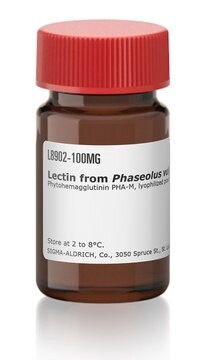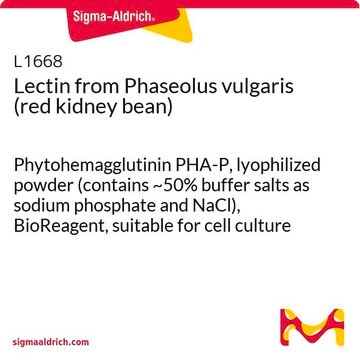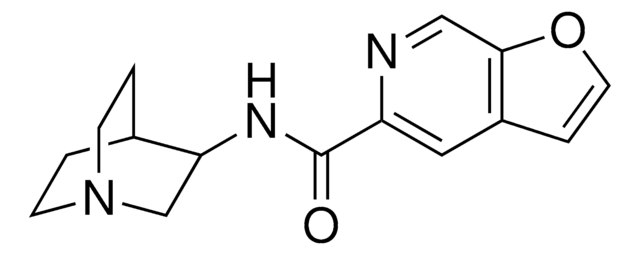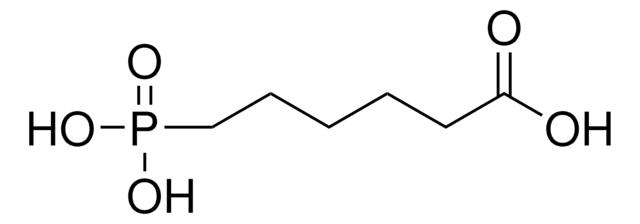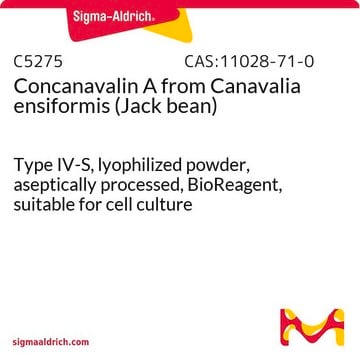11082132001
Roche
Phytohemagglutinin-M (PHA-M)
from Phaseolus vulgaris
Synonym(s):
PHA-M
Sign Into View Organizational & Contract Pricing
All Photos(1)
About This Item
UNSPSC Code:
23201100
Recommended Products
Quality Level
sterility
non-sterile; 0.2 μm filtered
form
lyophilized
packaging
pkg of 20 mg
manufacturer/tradename
Roche
application(s)
hematology
storage temp.
2-8°C
General description
Phytohemagglutinin (PHA), the lectin extract from the red kidney bean. PHA consists of five isolectins (L4E0, L3E1, L2E2, L1E3, L0E4) each being a tetramer held together by noncovalent forces. The subunits L (leukocyte reactive) have a high affinity for lymphocyte surface receptors, but little for those of erythrocytes, and are responsible for the mitogenic properties of the isolectins. E (erythrocyte reactive) is responsible for the erythrocyte-agglutinating properties.
Application
Phytohemagglutinin (PHA) is a potent mitogen used to stimulate cell proliferation in lymphocyte cultures.
Phytohemagglutinin-M (PHA-M) has been used in the activation of Jurkat and primary cells. It has also been used to treat polymorphonuclear blood cells(PMBCs)
Biochem/physiol Actions
Phytohemagglutinin (PHA) has mitogenic and potent cell agglutinating activities. It binds to T-cell membranes and stimulates cell division and metabolic activity. PHA has the ability to stimulate close contacts between cell membranes.
Specifications
Biological activity: <10 μg/ml for maximal stimulation of DNA synthesis (BrdU incorporation) with human peripheral blood lymphocytes.
Preparation Note
Working concentration: 2 - 10 μg/ml
Approximately 2 - 10 μg/ml for the stimulation of peripheral blood lymphocytes
Storage conditions (working solution): The reconstituted solution is stable for 2 weeks at 2 to 8 °C or for several months when stored in aliquots at -15 to -25 °C.
Approximately 2 - 10 μg/ml for the stimulation of peripheral blood lymphocytes
Storage conditions (working solution): The reconstituted solution is stable for 2 weeks at 2 to 8 °C or for several months when stored in aliquots at -15 to -25 °C.
Reconstitution
PHA-M should be reconstituted in sterile double-dist. water (final concentration: 2–10 mg/ml). Further dilution with medium or PBS (phosphate buffered saline).
Other Notes
For life science research only. Not for use in diagnostic procedures.
Storage Class Code
11 - Combustible Solids
WGK
WGK 1
Flash Point(F)
does not flash
Flash Point(C)
does not flash
Choose from one of the most recent versions:
Already Own This Product?
Find documentation for the products that you have recently purchased in the Document Library.
Customers Also Viewed
TRIM28 promotes HIV-1 latency by SUMOylating CDK9 and inhibiting P-TEFb
Ma X, et al.
eLife, 8, e42426-e42426 (2019)
Tania Del Rivero et al.
Frontiers in immunology, 13, 977809-977809 (2022-12-16)
Extracellular vesicles isolated from human amniotic fluid (AF-EVs) have previously been found to modulate inflammation and macrophage infiltration in a mouse model. However, the effects of acellular amniotic fluid (acAF) or AF-EVs on the T-Cell immune response have not been
Human-specific adaptations in Vpu conferring anti-tetherin activity are critical for efficient early HIV-1 replication in vivo
Yamada E, et al.
Cell host & microbe, 23(1), 110-120 (2018)
Julia Kölle et al.
iScience, 25(6), 104440-104440 (2022-06-17)
The cytokine interleukin-3 (IL-3) acts on early hematopoietic precursor cells. In humans, Treg cells secrete IL-3 and repress inflammatory cells except for basophils. The present study aims to elucidate the contribution of IL-3 in the development and the course of
Polyfunctional Melan-A-specific tumor-reactive CD8+ T cells elicited by dacarbazine treatment before peptide-vaccination depends on AKT activation sustained by ICOS
Ornella Franzese
Oncoimmunology, 5(5), e1114203-e1114203 (2016)
Our team of scientists has experience in all areas of research including Life Science, Material Science, Chemical Synthesis, Chromatography, Analytical and many others.
Contact Technical Service

